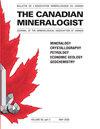含碳酸盐的磷hedyphane——“羟基磷hedyphine”和铈矿:二叠纪细晶岩中方铅矿蚀变的浅生产物(斯洛伐克喀尔巴阡山西部)
IF 1.5
4区 地球科学
Q3 MINERALOGY
引用次数: 2
摘要
与方铅矿、铈矿和方解石相关的磷灰石超群的hedyphane族矿物的独特组合出现在二叠纪细晶岩脉中,该细晶岩岩脉横切正片麻岩,属于斯洛伐克中部喀尔巴阡山脉西部Veporic单元的VeýkýZelenýPotok山谷的前阿尔卑斯基底。次生Ca-Pb磷酸盐包括磷酸hedyphane Ca2Pb3(PO4)3Cl和(OH)占主导地位的“羟基膦基膦”Ca2Pb3(PO3)3OH。hedyphane族矿物的详细EPMA和拉曼光谱揭示了Pb、Ca、P和Cl作为主要成分的存在;系统存在的(CO3)2-(高达2.6 wt.%CO2calc;0.65 apfu C)取代(PO4)3-(B型)是自然界中第一个报道的含碳酸盐的磷杂环乙烷。此外,还存在显著的局部卤素缺乏症(0.38–0.49 apfu Cl+F),这表明存在一种新矿物“羟基膦酸”的潜力。本文所述的次生组合是由非常低温的硫化物-碳酸盐反应以及碱性富CO2地下水中原生岩浆或变质磷酸盐矿物(主要是磷灰石)和热液方铅矿的进一步近地表浅生蚀变引起的。本文章由计算机程序翻译,如有差异,请以英文原文为准。
Carbonate-bearing phosphohedyphane–“Hydroxylphosphohedyphane” and cerussite: Supergene products of galena alteration in Permian aplite (Western Carpathians, Slovakia)
A unique assemblage of hedyphane-group minerals of the apatite supergroup associated with galena, cerussite, and calcite occurs in a Permian aplite dike crosscutting orthogneisses belonging to the pre-Alpine basement of the Veĺký Zelený Potok Valley in the Veporic Unit, Western Carpathians, Central Slovakia. The secondary Ca-Pb phosphates include phosphohedyphane Ca2Pb3(PO4)3Cl and (OH)-dominant “hydroxylphosphohedyphane” Ca2Pb3(PO4)3OH. Detailed EPMA and Raman spectroscopy of the hedyphane-group minerals reveal the presence of Pb, Ca, P, and Cl as major constituents; the systematic presence of (CO3)2– (up to 2.6 wt.% CO2calc; 0.65 apfu C) substituting for (PO4)3– (B-type) is the first reported carbonate-bearing phosphohedyphane in nature. There is also significant localized halogen deficiency (0.38–0.49 apfu Cl+F) which suggests the potential for a new mineral, “hydroxylphosphohedyphane”. The secondary assemblage described herein results from very low-temperature sulfide-carbonate reactions and further near-surface supergene alteration of primary magmatic or metamorphic phosphate minerals (mainly apatite) and hydrothermal galena in the alkaline CO2-rich groundwater.
求助全文
通过发布文献求助,成功后即可免费获取论文全文。
去求助
来源期刊

Canadian Mineralogist
地学-矿物学
CiteScore
2.20
自引率
22.20%
发文量
45
审稿时长
4-8 weeks
期刊介绍:
Since 1962, The Canadian Mineralogist has published papers dealing with all aspects of mineralogy, crystallography, petrology, economic geology, geochemistry, and applied mineralogy.
 求助内容:
求助内容: 应助结果提醒方式:
应助结果提醒方式:


